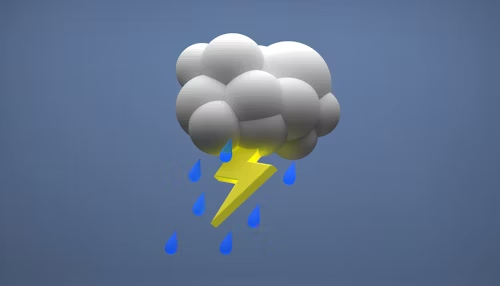AI Revolutionizes Weather Forecasting: A Leap Beyond Supercomputers

For decades, weather forecasting has relied heavily on powerful supercomputers crunching complex mathematical models to predict the whims of nature. But that era is being swiftly transformed. A groundbreaking innovation from the University of Pennsylvania and Microsoft introduces Aurora — an AI-driven model that promises to outperform traditional forecasting systems in speed, accuracy, and adaptability.
This game-changing advancement isn’t just about knowing whether it will rain tomorrow — it’s about redefining how we prepare for climate events, natural disasters, and even agricultural planning in real time.
Meet Aurora: The AI That Sees the Storm Coming
Developed by Professor Paris Perdikaris and his research team, Aurora is a deep-learning model trained on decades of meteorological data, satellite imagery, and climate simulations. Unlike traditional models that simulate atmospheric physics using brute-force computations, Aurora leverages neural networks to learn patterns in weather behavior. Aurora is not just a typical AI model relying solely on surface-level weather data — it’s a physics-informed neural network (PINN) that combines decades of real-world meteorological data, satellite imagery, and atmospheric observations with the fundamental physical laws of fluid dynamics and thermodynamics. This unique hybrid approach enables Aurora to capture both the statistical patterns in weather behavior and the underlying scientific principles driving those patterns — a capability that traditional machine learning models often lack.
“Aurora doesn’t simulate the weather—it understands it,” said Perdikaris.
Why Aurora Is a Game Changer
- Speed: Aurora can generate forecasts in mere seconds, compared to hours needed by supercomputers like the European Centre for Medium-Range Weather Forecasts (ECMWF) model.
- Accuracy: Aurora delivers more precise predictions, particularly for extreme events like hurricanes, flash floods, and heatwaves — scenarios where every minute and meter matter.
- Efficiency: It runs on significantly less energy, which reduces costs and carbon emissions — a crucial benefit as the world seeks greener tech solutions.
Real-World Applications
-
Disaster Preparedness and Emergency Response
AI-based forecasting can predict the onset, path, and intensity of extreme weather events like hurricanes, floods, wildfires, and heatwaves more accurately. This gives governments and aid organizations:
- Longer lead times to issue warnings and evacuations
- Higher confidence in predicting where and when disasters will strike
- Better resource allocation, such as deploying emergency personnel and supplies ahead of time
Example: During hurricane season, Aurora could offer hyper-local predictions that help cities strengthen infrastructure and evacuate only the necessary regions — reducing panic and saving costs.
2. Precision Agriculture
In regions where farming is highly weather-dependent, Aurora could provide farmers with:
- Accurate rainfall and temperature forecasts to guide sowing and harvesting schedules
- Irrigation planning based on soil moisture predictions
- Disease risk predictions by modeling how weather affects pest or fungus outbreaks
Impact: This improves crop yields, reduces water usage, and minimizes losses — especially crucial for regions vulnerable to climate change.
3. Aviation and Transportation
Aurora’s real-time, high-resolution forecasts allow airlines and logistics companies to:
- Avoid turbulence or severe weather zones
- Plan safer and more fuel-efficient routes
- Reduce delays and cancellations
For ground logistics and delivery services, Aurora enables proactive route planning during storms or snowfalls, improving customer satisfaction and driver safety.
4. Urban Planning & Infrastructure Management
City planners can use Aurora to:
- Predict urban heat islands, guiding where to plant trees or design cooling systems
- Monitor air quality and wind patterns to inform ventilation and pollution control strategies
- Model flood risks and plan drainage systems accordingly
In smart cities, AI-based weather integration could trigger automated alerts or even autonomous actions like closing floodgates or adjusting traffic signals during extreme weather.
Human + Machine: Not a Replacement, But an Upgrade
While AI like Aurora is incredibly powerful, it’s designed to support human meteorologists, not replace them. Here’s how that collaboration works:
Meteorologists Add Context, Interpretation, and Communication
Aurora excels at pattern recognition, but it doesn’t understand context the way humans do. Meteorologists:
- Interpret results using local knowledge, such as microclimates or historical anomalies
- Identify false positives or rare edge cases where AI might misread data
- Translate data into action, creating understandable messages for the public, media, and authorities
Example: An AI model may predict a storm’s path, but a meteorologist can explain its real-world implications to schools, emergency managers, or news agencies.
A Vision of the Future
Aurora is more than a forecasting tool — it represents a paradigm shift in how we interact with and respond to environmental data. With global warming intensifying weather extremes, the need for faster, more reliable, and more accessible forecasting is greater than ever.
Whether it’s helping small farmers in rural areas, saving lives during hurricanes, or guiding airline traffic safely, Aurora shows how AI can be a force multiplier for human decision-making in the face of climate uncertainty.
“We are entering an era where AI doesn’t just report the weather — it helps shape how we live with it.”







